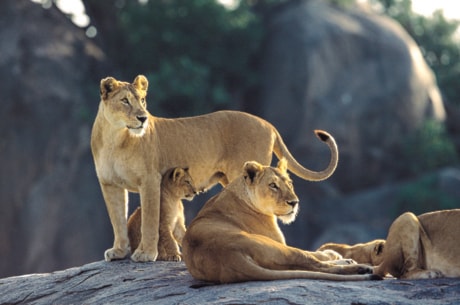African Cats Three stars (out of 4) Rated: G
A real-life The Lion King similarly aimed at a family audience, African Cats nevertheless takes an adult approach to the fight-or-be-eaten reality of life in the wild.
The third film from the new Disneynature offshoot of Uncle Walt’s kingdom, following Earth and Oceans, is also the best.
It benefits from a narrower focus and a greater willingness to reveal harsh truths, within limits. Teeth are bared, but the sight of blood is spared.
There’s no escape claws in this often brutal saga of two wild African mothers, a lioness and a cheetah, as they seek to protect their offspring from predators of all kinds. Danger threatens both directly and indirectly, from attack and from abandonment.
Narrator Samuel L. Jackson sets the dramatic tone for African Cats, making animal instincts sound like human cunning.
He depicts the East African grasslands as a setting more akin to a Quentin Tarantino movie than a Walt Disney, a ‘hood where only the strong, the wily and the lucky survive.
“Only by showing extraordinary courage would these mothers prevail,” Jackson intones, and indeed, he’s not exaggerating.
Extraordinary photography, and dogged work by co-directors Keith Scholey and Alastair Fothergill, justify the florid narrative.
The feline moms live on either side of an unnamed river that is populated by crocodiles (the film was shot in Kenya’s Masai Mara National Reserve).
To the south is lioness Layla, lead hunter for the River Pride, a family of lionesses ruled by the aptly named male lion Fang (although he’s missing a front tooth, lost in a fight).
Layla has a 6-month-old cub named Mara, who is not old enough yet to hunt for her own food. But mom is getting older and slower. Layla is wincing from recent injuries, including a zebra kick that has left her permanently hobbled.
Despite her pain, Layla must provide for her daughter while also keeping up with the pride’s seasonal moves.
Fang waits for no one, and without him, predators turn bolder. He’s brave and tough enough to scare away a crocodile, but even he might prove no match for a pack of testosterone-pumped tabbies that repeatedly charge the pride.
On the north bank of the river, cheetah mom Sita is having an even tougher go of it. She’s a “single mother” with five newborn cubs to care for, and she has no male protector at all. Everything from rapacious hyenas to bullying male teen cheetahs threaten Sita’s brood.
The anthropomorphizing gets a bit much at times, with Jackson attributing “mother love” and “vengeance” to animal actions that are really just the rule of nature. Nicholas Hooper’s soundtrack, alternately threatening and syrupy, underlines the empathy overkill.
There’s no denying the amazing visuals, however. Co-directors Scholey and Fothergill spent more than 21/2 years gathering these images, which include high-speed photography of a charging cheetah, the fastest animal on land, as it stalks the wildebeest that will soon become dinner.
It’s enough to take your breath away, but not to lose your lunch. The camera spares viewers, especially fearful younger ones, of explicit blood and gore.
That’s a wise decision by Disneynature. It wants to inspire today’s young people to love and respect the Earth, the same way their Boomer parents did watching TV’s The Wonderful World of Disney in the 1960s and ‘70s.
It would be fascinating, however, to see an “R”-rated cut of a film like African Cats, which doubtless would rival any horror film for scarlet truth.
Peter Howell is a syndicated movie critic for The Toronto Star.
